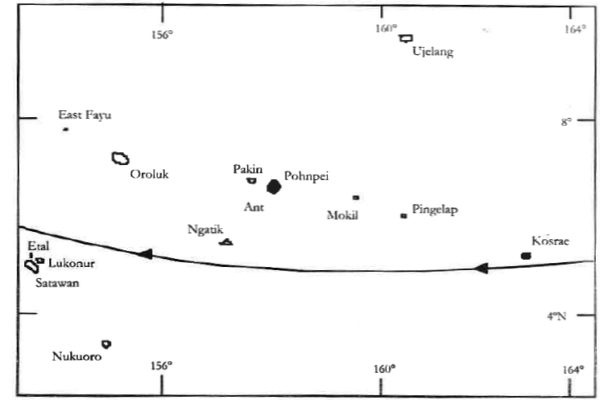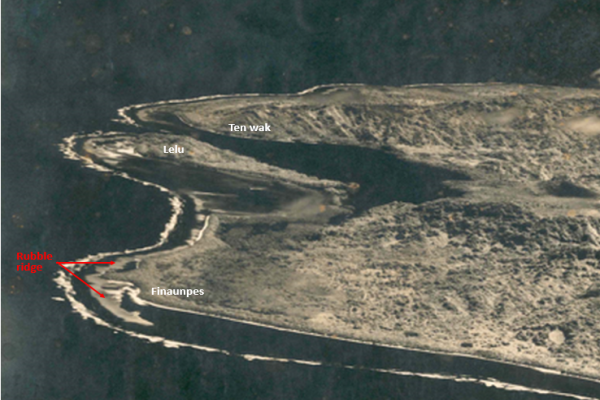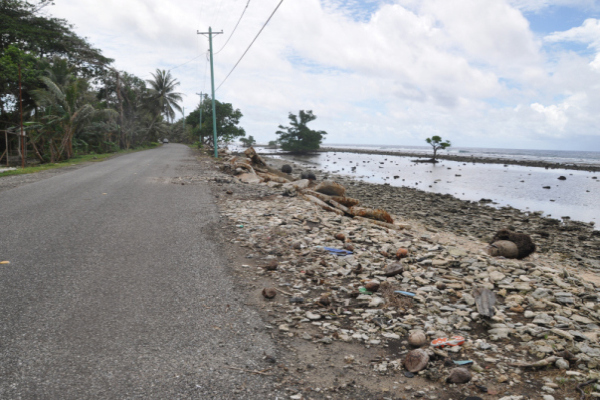The typhoon of the 4-5 March 1891 caused extensive damage on Kosrae and was responsible for a number of deaths, the loss of virtually all buildings, and destruction of food crops. Large waves during the typhoon also resulted in a large bank of coral rubble being deposited on the reef flat between Finaunpes to Putukte and Ten Wak to Kuplu. This rubble ridge, and its subsequent removal for construction material, has played a significant role in influencing coastal change on the eastern Lelu and Malem coastlines over the last 120 years to the present day.
Climatic conditions in the Pacific in early 1891 were beginning to indicate the development of a weak El Nino over the northern hemisphere summer period. Kosrae tends to have an increased risk of being impacted by a typhoon during periods of El Nino.
A summary of the typhoon and its impacts is provided in the book Island of Angels (Buck, 2005) from historical missionary accounts, and in Typhoons in Micronesia (Spennemann, 2004) from which the following has been sourced.
Timeline
- Monday, 3 March: rained hard all day
- Tuesday, 4 March: Strong winds rising to gale force during the morning, typhoon winds all afternoon, night, and in to Wednesday morning.
- Wednesday, 5 March: Winds ease as the typhoon eye passes over Kosrae late morning/noon, 3 pm winds rise again and by 4pm typhoon winds again causing damage throughout the night.
- Thursday, 6 March: Winds ease as typhoon moves west away from Kosrae.
Details
From missionary accounts:
“It rained hard all day Monday, then on Tuesday morning it began to blow, and it was so dark we had to have lamps……….But the storm was growing worse and worse, the house creaking and straining. We then heard the timbers breaking and the iron roof and shingles begin flying in every direction….”
“Tuesday morning a strong wind commenced blowing. We did not think it more than a trade wind, but it blew stronger till it reached gale. The first warning we had there night be danger, our trees commenced blowing down. Soon after this we saw our house was not going to stand long. We only had time to get the girls together, and had not been out of the house more than twenty minutes when the roof fell. The storm raged all night. Wednesday morning the Kuasaien house where we had taken shelter began to go so we passed on up to the king’s place. Trees were falling in every direction.”
“At three o’clock that afternoon the winds rose again. At four it raged. Great trees were crashing down, flinging their great branches through the air. Our veranda posts stood out in mid-air, and still the wind rose……….Still the wind rose, lightening flashed, the sea roared, and rain fell in torrents. We watched for morning.”
“Morning always does come and it did that time, and with it such a picture of desolation as it had never been my lot to see before. What few trees were left were leafless and broken, and the wind sounded dry and wintry through them. The coconut trees stood with their heads off. All the breadfruit, limes and bananas and things of that kind were on the ground. The island looked as if a great fire had overspread it. Not a church was left standing, most of the native houses were down, and no thatch plants were left with which to build.”
“At Lelu seven houses only are reported as habitable, and those were only kept so by constant propping. At South Harbour every house is down but one, and that has no roof. Malem very few houses are down, but the waves were so high and furious that the water came in to them, so that the people had to hang around the sides of the houses in order to keep out of it.”
“Pastor Likiaksa and his family were in their Utwe house when the winds began to blow. One after another the houses of the village were partially or totally destroyed as the hours and the days of the storm continued – even the roof of Utwe’s stone church was lifted off and carried away.”
“At two places the hurricane has thrown up a wall of rocks on the reef for some distance, so high that the breakers cannot be seen above it. This makes a smooth passage for canoes between the shore and it, which sometimes used to be very rough. The oldest people on the island remember hearing others tell of just such another hurricane eighty or ninety years ago, which lasted but one day and night.”
The summary by Spennemann (2004) is as follows:
The 3-4 March 1891 typhoon, which was very destructive on Ngatik and Kosrae, was also felt on Jaluit but only to a much lesser extent, presumably as a tropical storm. Gaining momentum as it travelled west, the typhoon became severe over Kosrae, but seem to have only been felt as a storm on Pohnpei. In the absence of wind directions we cannot reconstruct whether the typhoon passed Kosrae to the north or, as is more likely based on the damaged described, to the south. The 1891 typhoon on Kosrae damaged or destroyed most of the island and its buildings and threw up a two meter high and three to four kilometres long hurricane bank on the reef platform. The mission histories report that “scarcely half a dozen houses were left standing on Kusaie, and the breadfruit and coconut trees are almost wholly destroyed. The Gilbert Islands settlement suffered the most; all but two or three of their native houses were destroyed.” The damage level observed is indicative of a typhoon of greater than 100 knots wind speed. The missionaries’ house was unroofed and its contents soaked. Corrugated iron sheeting from the girl’s school roof was blown for several hundred metres. The devastation of the food supply resulted in severe food shortages.
Aftermath
Most of the homes and all of the churches experienced considerable damage or were completely destroyed along with all the crops.
In the immediate aftermath sweet potato, a fast growing crop, was planted. This is a traditional coping mechanism on many Pacific Islands. Survivors lived on fish and wild roots until the sweet potato crops were ready.
Despite there only being a few deaths as a direct result of the typhoon, sickness and famine during the following weeks took many more lives, including five Pohnpeian girls at the mission school due to dysentery.
References
Accounts of Miss J Hopkins, Mary Channon, Estelle Fletcher and Harriet Pease as recounted in: Buck, E.M. 2005. Island of Angels. The growth of the church on Kosrae. Kapakapak lun church fin can Kosrae, 1852 – 2002. Watermark Publishing.
Spennemann, D.H.R. 2004. Typhoons in Micronesia. A history of tropical cyclones and their effects until 1914. Division of Historic Preservation, Sapian, CNMI.













